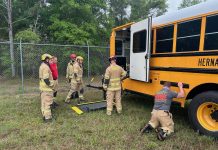Two young students lost their lives last week after attempting to cross the street on their own — one was struck by the rear tire of a yellow bus and the second by a truck driver who illegally passed her bus. Every year a dozen or more schoolchildren are killed around their school bus or bus stop, and most accidents occur while they are crossing the road.
School bus safety consultants Jeffrey Cassell and Ted Finalyson-Schueler emphasize that training young pedestrians is the best way to prevent such tragedies.
Police in Macon, Ga., said 5-year-old Ta’Miya Watson died April 22 after being hit outside of Barden Elementary School. Witnesses reported the kindergartener ran off the curb, turned around to talk to kids behind her and walked into the side of bus. Tamiya died later that evening at a local hospital.
“In the past eight years, 92 children were killed in the danger zones of school buses — an average of almost 12 each year. In almost every catastrophe, had the child acted correctly, every one of these children would still be alive,” said Cassell, who is president of the School Bus Safety Company and a former safety director for Laidlaw. “Twelve of the deaths were due to children who stayed close to the side of the bus — they did not know to stay five giant steps away.”
On April 23, in Sampson County, N.C., a 7-year-old girl exited her school bus and began crossing the road toward her mother when she was struck by a hit-and-run driver. The truck approached from the rear of the stopped bus — which had all signals activated — then passed it and hit the child. The driver has since been charged with felony hit-and-run and felony passing a stopped school bus.
Thirty-seven of the student fatalities Cassell has tracked since 2005 occurred when children were crossing the street.
“Had the child followed safe crossing procedures, they would still be alive,” Cassell told STN. “We train the school bus drivers to do all they can to avoid danger-zone accidents, and it is imperative we also train the students in safe school bus practices.”
The goal of his company, which produces training programs for school bus staff as well as the students they serve, is to reduce such fatalities from Twelve to Zero, which is the name of a four-pronged campaign including comprehensive training for bus drivers, motorists and children.
Ted Finlayson-Schueler, a school-zone safety expert and president of Safety Rules!, said that student fatality numbers have dropped significantly since the 1980s, which he considers proof that, as an industry, “We are doing better.”
In the late 1980s and early 1990s, he said trainers in New York State adopted a new program emphasizing proper crossing procedures. Finlayson-Schueler said that back then, an average of 2.7 kids were killed at bus stops annually, and since 1990, the average has been 0.4.
New York school buses transport about 10 percent of students in the nation, he continued. From 1991 to 2012, there was an average of 15 fatalities per year nationally: One-tenth of that figure would be 1.5, but New York’s average is merely one-third of that. Why? Because proper crossing procedures make a difference, noted Finlayson-Schueler.
“In some states, once the kids get off the bus they are pretty much on their own,” Finlayson-Schueler said. “In New York, when children get off the bus, they have to look at and make eye contact with the driver before proceeding across the road. Bus drivers signal them when it’s safe to cross and … in the afternoon, when kids are getting off, drivers make sure no one is passing the bus on the righthand side.”
The bus driver blows the horn if the child hasn’t checked the road, and the child has to return to the curb again. Because the driver is elevated, he or she has the best chance to see what’s happening, he explained.
“Everybody makes mistakes. That’s why the driver and the child have to have a plan in place so they are being vigilant throughout the process,” he added.















